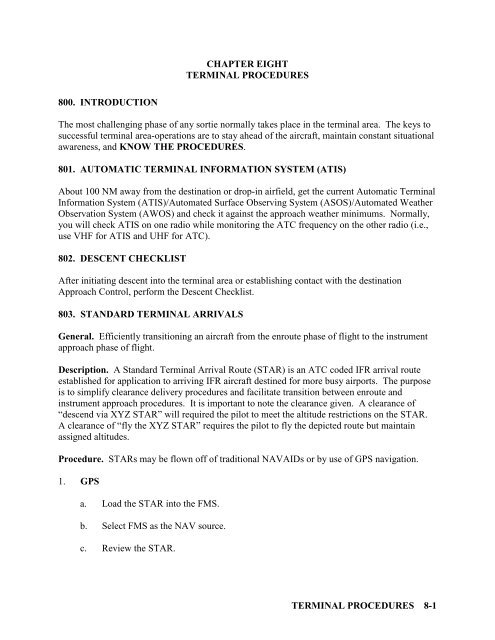Flight Training Instruction - Cnatra - U.S. Navy
Flight Training Instruction - Cnatra - U.S. Navy
Flight Training Instruction - Cnatra - U.S. Navy
You also want an ePaper? Increase the reach of your titles
YUMPU automatically turns print PDFs into web optimized ePapers that Google loves.
800. INTRODUCTION<br />
CHAPTER EIGHT<br />
TERMINAL PROCEDURES<br />
The most challenging phase of any sortie normally takes place in the terminal area. The keys to<br />
successful terminal area-operations are to stay ahead of the aircraft, maintain constant situational<br />
awareness, and KNOW THE PROCEDURES.<br />
801. AUTOMATIC TERMINAL INFORMATION SYSTEM (ATIS)<br />
About 100 NM away from the destination or drop-in airfield, get the current Automatic Terminal<br />
Information System (ATIS)/Automated Surface Observing System (ASOS)/Automated Weather<br />
Observation System (AWOS) and check it against the approach weather minimums. Normally,<br />
you will check ATIS on one radio while monitoring the ATC frequency on the other radio (i.e.,<br />
use VHF for ATIS and UHF for ATC).<br />
802. DESCENT CHECKLIST<br />
After initiating descent into the terminal area or establishing contact with the destination<br />
Approach Control, perform the Descent Checklist.<br />
803. STANDARD TERMINAL ARRIVALS<br />
General. Efficiently transitioning an aircraft from the enroute phase of flight to the instrument<br />
approach phase of flight.<br />
Description. A Standard Terminal Arrival Route (STAR) is an ATC coded IFR arrival route<br />
established for application to arriving IFR aircraft destined for more busy airports. The purpose<br />
is to simplify clearance delivery procedures and facilitate transition between enroute and<br />
instrument approach procedures. It is important to note the clearance given. A clearance of<br />
“descend via XYZ STAR” will required the pilot to meet the altitude restrictions on the STAR.<br />
A clearance of “fly the XYZ STAR” requires the pilot to fly the depicted route but maintain<br />
assigned altitudes.<br />
Procedure. STARs may be flown off of traditional NAVAIDs or by use of GPS navigation.<br />
1. GPS<br />
a. Load the STAR into the FMS.<br />
b. Select FMS as the NAV source.<br />
c. Review the STAR.<br />
TERMINAL PROCEDURES 8-1
















